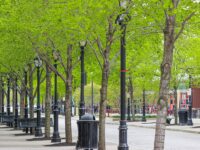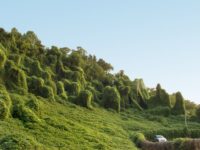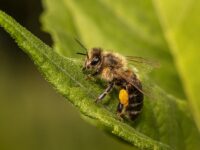Lawns have long been the sign of a clean and respectable neighborhood, causing U.S. homeowners to maintain weekly or even daily upkeep on 40 million acres of lawn nationwide. The history and environmental impact of a trim yard, though, suggests the grass is not always greener with traditional lawns.
British colonizers initiated today’s concept of a lawn by bringing grasses from Europe and Northern Africa across the Atlantic to replace nutrient-poor native grasses that could not sustain livestock. As foreign seed production grew, what began as a farming necessity turned into a residential luxury. European aesthetics influenced figures like George Washington to curate fields of manicured grass, and wealthy Americans were driven to emulate this symbol of status.
A 19th-century lawn was only tangible to those with the means to maintain it, requiring time for trimming and money for watering. Economic growth eventually allowed more homeowners to have yards, but this only exacerbated the grandiosity of lawns and perpetuated their close ties to high class and social status.
In 2017, households spent an average of $503 on lawn care and gardening activities. This costly annual expenditure is indicative of the amount of resources lawn upkeep demands. Lawns in the United States require an excess of resources like water, fertilizer, and pesticides because they are composed of plants not native to the Americas. This excess of resources means lawns come at a hefty price not just for Americans but also for the environment.
In 2017, households spent an average of $503 on lawn care and gardening activities.
Comparing lawn irrigation methods, NASA researcher Cristina Milesi estimates that “domestic and commercial consumptive water use would be [184 to 238 gallons] of water per person per day.” For reference, medical professionals recommend just under one gallon of water per day for the average man — this means that 200 people could receive clean drinking water per person per day if water allocation for lawns was refocused. In places that suffer from water scarcity, like the western U.S., people have even begun to “drought shame” neighbors with suspiciously green lawns.
Excessive use of water on lawns is compounded by the impacts of mowers, fertilizers, and pesticides. The U.S. Environmental Protection Agency attributes 5 percent of air pollution, over 17 million gallons of spilled gasoline per year, and equivalent emissions of 11 cars driven for one hour to lawn mowers. Each year the U.S. uses 90 million pounds of fertilizer and 78 million pounds of pesticides, both of which contain harsh chemicals that find their way into delicate ecosystems, the air, and drinking water.
To best combat the harmful nature of lawns, American homeowners will have to change their idea of what a luxurious yard is. While retaining a patch of low-cut lawn may be advantageous for homeowners with children, others can consider swapping out meticulously groomed carpets for native varieties of groundcovers and ornamental grasses, which can reduce or eliminate the need for unsustainable upkeep. Groundcovers, including thyme and oregano, provide a similar look to that of lawns in that they spread wide, do not grow tall, and discourage weeds. Ornamental grasses can serve as the leafy aspect of a lawn, creating features like clumps or bushes. Other options for a sustainable lawn include mosses, shrubs, and wildflowers.
Each year the U.S. uses 90 million pounds of fertilizer and 78 million pounds of pesticides, both of which contain harsh chemicals that find their way into delicate ecosystems, the air, and drinking water.
Choosing a native variety of these types of plants significantly decreases required maintenance. Unlike modern day lawns, native plants do not need to be watered, mowed, or fertilized because they are designed to thrive under the sun, climate, and precipitation conditions that they are growing in. This means reclaiming hundreds of thousands of gallons of water each year, eliminating a massive source of pollution, and increasing carbon capture since native plants produce longer roots.
Native plants also invite other welcomed advantages: wildlife. Increased plant diversity creates habitats for myriad insects and birds, allowing a vibrant ecosystem to form. Transitioning to native landscapes helps both the health of a yard and the environment as a whole.
Though lawns have long been a symbol of status and wealth, the suffering environment begs for a reevaluation of what is important. Native plant gardens would greatly decrease resources spent on lawn care, conserve water supply, and cut pollution — not to mention the added benefits of biodiversity. It is time to leave lawns behind and let native plants take root.
Sources: 1
Image Source: CBS News





